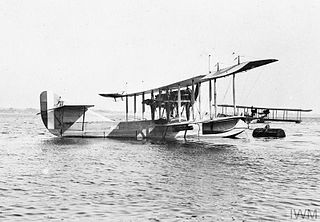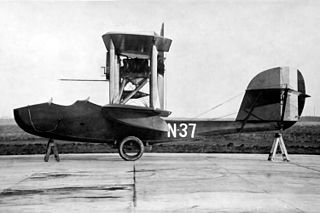
A seaplane is a powered fixed-wing aircraft capable of taking off and landing (alighting) on water. Seaplanes are usually divided into two categories based on their technological characteristics: floatplanes and flying boats; the latter are generally far larger and can carry far more. Seaplanes that can also take off and land on airfields are in a subclass called amphibious aircraft, or amphibians. Seaplanes were sometimes called hydroplanes, but currently this term applies instead to motor-powered watercraft that use the technique of hydrodynamic lift to skim the surface of water when running at speed.

The Supermarine S.4 was a 1920s British single-engined single-seat monoplane racing seaplane built by Supermarine to compete in the 1925 Schneider Trophy. It crashed and was destroyed before the competition started.
The Green Engine Co was a British engine company founded by Gustavus Green in Bexhill to sell engines of his design. He flourished especially as a designer of aeroplane engines during the first two decades of the 20th century. The engines were actually manufactured by the Aster Engineering Company.

The Curtiss Models F made up a family of early flying boats developed in the United States in the years leading up to World War I. Widely produced, Model Fs saw service with the United States Navy under the designations C-2 through C-5, later reclassified to AB-2 through AB-5. Several examples were exported to Russia, and the type was built under license in Italy.

The Curtiss Model H was a family of classes of early long-range flying boats, the first two of which were developed directly on commission in the United States in response to the £10,000 prize challenge issued in 1913 by the London newspaper, the Daily Mail, for the first non-stop aerial crossing of the Atlantic. As the first aircraft having transatlantic range and cargo-carrying capacity, it became the grandfather development leading to early international commercial air travel, and by extension, to the modern world of commercial aviation. The last widely produced class, the Model H-12, was retrospectively designated Model 6 by Curtiss' company in the 1930s, and various classes have variants with suffixed letters indicating differences.

The Norman Thompson N.T.4 was a twin-engined British flying boat of the First World War. Although less well known than similar Curtiss and Felixstowe flying boats, 50 were ordered for Britain's Royal Naval Air Service.

The Supermarine Sea Lion II was a British racing flying boat built by the Supermarine Aviation Works. Designed by Reginald Mitchell, it was a modification of Supermarine's Sea King II. Sea Lion II was powered by a 450 hp (340 kW) Napier Lion engine.
The Gloster II was a British racing floatplane of the 1920s. A single-engined biplane, two were built to compete in the 1924 Schneider Trophy air race. However the crash of the first prototype during testing meant that it could not be made ready for the race, which was postponed. The second aircraft was also lost in a crash.

The White & Thompson Bognor Bloater was a British First World War two-seat reconnaissance biplane. It was designed and built by White & Thompson Limited of Middleton-on-Sea, near Bognor Regis, Sussex for the Admiralty as a competitor to the Royal Aircraft Factory BE.2. Designated N.T.3 by White & Thompson, it is not known if there was an official designation for the aircraft, which was known in service with the nickname Bognor Bloater.
The Wight Twin was a British large twin-engined aircraft of the First World War. It was a twin-engined, twin boom biplane. One was built as a landplane for France, while three more similar aircraft were built as Seaplanes for the British Royal Naval Air Service. Both versions were unsuccessful and saw no service.

The Norman Thompson N.T.2B was a British single-engined flying boat trainer of the First World War. A single-engined biplane, the N.T.2B was adopted as a standard flying boat trainer by the Royal Naval Air Service, training pilots for larger patrol flying boats such as the Felixstowe F.2.

The White and Thompson No. 3 was a British flying boat of the First World War. While the prototype was originally designed to compete in an air-race around the UK, eight more similar aircraft were built for the Royal Naval Air Service.

The Norman Thompson N.1B was a prototype British flying boat fighter aircraft of the First World War. A two-seat single-engined pusher biplane, a single example was built in 1917, but no production followed.

The Sopwith Bat Boats were British flying boats designed and built from 1912 to 1914. A single-engined pusher biplane, the Bat Boat was the first successful flying boat and amphibious aircraft built in the United Kingdom, with examples used by the Royal Navy and by Greece and Germany.

The Short S.41 was a British single-engined biplane built for the Royal Navy in 1912. Capable of being operated either on wheels or floats, it was successful enough for a further two similar aircraft to be built, with the type remaining in use until the early years of the First World War.

The Curtiss C-1 Canada was a twin-engined bomber aircraft of the First World War which was designed by Curtiss of America to be built by their Canadian subsidiary for the British Royal Naval Air Service and Royal Flying Corps. Although large orders were placed, only twelve were built, the type being rejected in favour of more capable aircraft such as the Handley Page O/100.
The Norman Thompson Flight Company was a British aircraft manufacturer specialising in the construction of flying boats. It was formed as the White and Thompson Company in 1912, and designed and built the Norman Thompson NT.4 patrol aircraft and the N.T.2B flying boat trainer for the Royal Naval Air Service during the First World War, but production problems led to the company entering receivership in 1918, being liquidated in 1919.

The Wanamaker Triplane or Curtiss Model T, retroactively renamed Curtiss Model 3 was a large experimental four-engined triplane patrol flying boat of World War I. It was the first four-engined aircraft built in the United States. Only a single example (No.3073) was completed. At the time, the Triplane was the largest seaplane in the world.
The Sage Type 4 was a prototype British floatplane of the First World War. It was a designed as a two-seat reconnaissance aircraft for the Royal Naval Air Service, but was chosen for service as a floatplane trainer, although the end of the war resulted in production being cancelled.

















